The BBEN MN10 is the second Apollo Lake device to be released in the stick form-factor and on paper looks to have a lot to offer:
It features an Apollo Lake N3350 SoC, an unusual 3GB of RAM, 64GB of storage and is cooled by a ‘mute’ fan. The devices comes in a plain box with a power adapter, and a leaflet style manual.
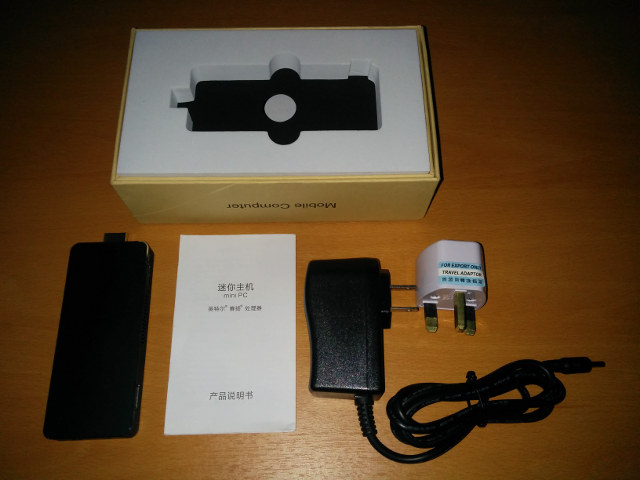
It also included a three-pin UK power adapter, as this was advertised as the ‘BBen MN10 Mini PC – UK PLUG BLACK’.
Looking at the detail specifications:
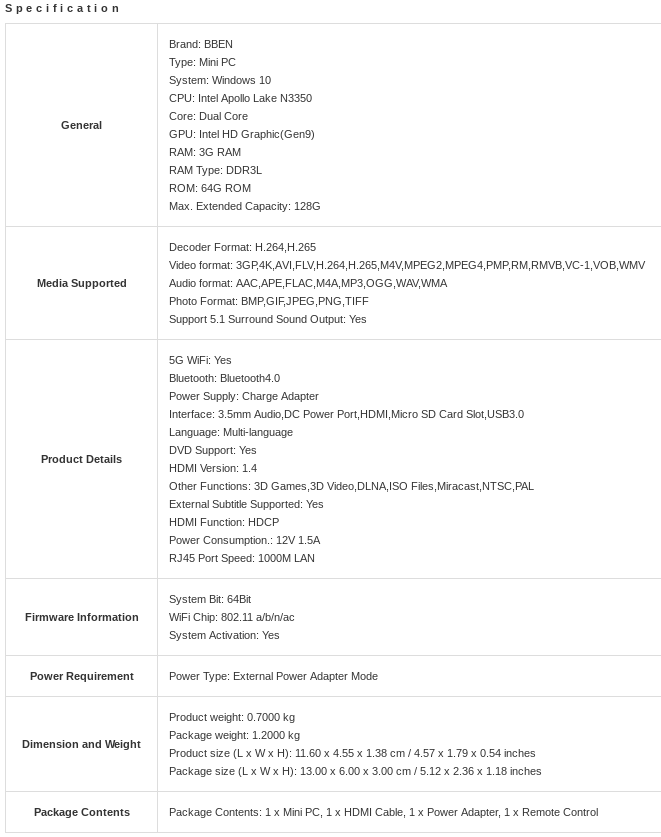
We can immediately see discrepancies as the device does not have a ‘RJ45 Port Speed: 1000M LAN’ port, and was not supplied with ‘1 x HDMI Cable’ nor ‘1 x Remote Control’.
Powering on the device and the ‘mute’ fan is also a miss-representation as it starts immediately and is noticeably noisy. It also runs at full speed regardless of workload so the noise is a constant reminder that the device is switched-on:
Starting Windows and the disappointment continues with a message informing that ‘We can’t activate Windows on this device because you don’t have a valid digital license or product key’:
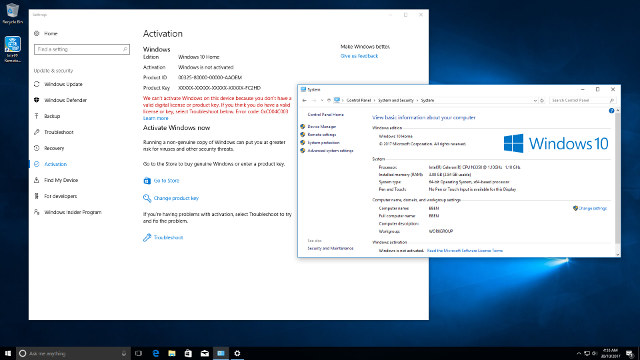
also ‘Intel Remote Keyboard Host App’ is pre-installed (see icon top left) and the computer name is already been set as ‘BBEN’.
As a result I tried installing Microsoft’s Windows 10 Home ISO but because of the confirmed lack of license, I then installed Microsoft’s Windows 10 Enterprise product evaluation ISO in order to review the device.
The basic hardware matched the specification:
with plenty of free-space available post installation:
I then ran some standard benchmarking tools to look at performance under Windows. These are a new set of benchmarks as I’ve updated the tools and releases specifically for devices running Windows version 1709 and later:
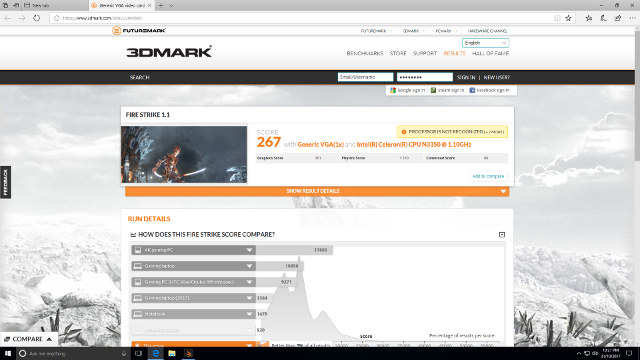
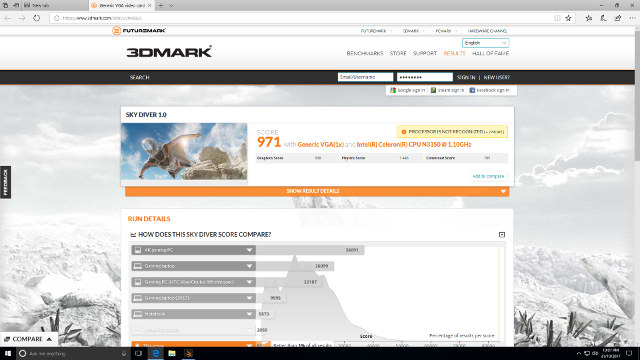
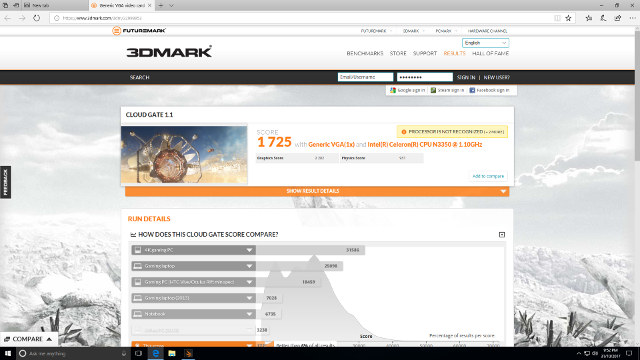
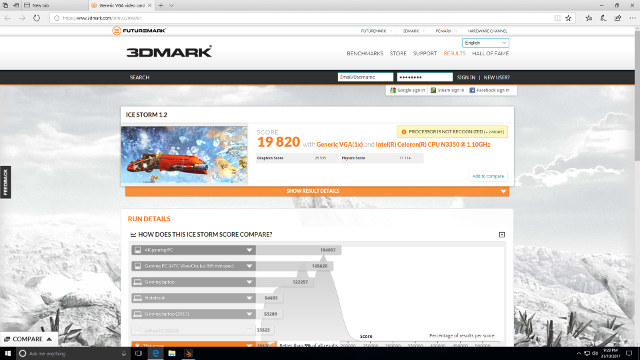
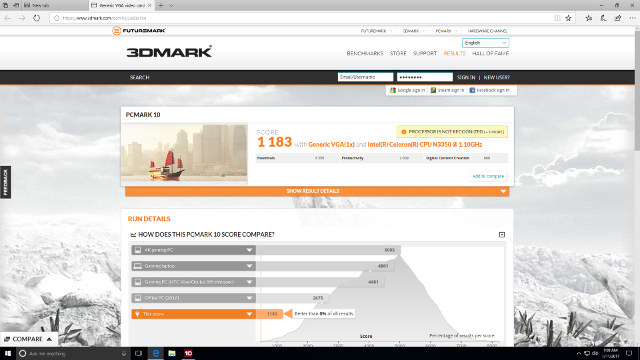
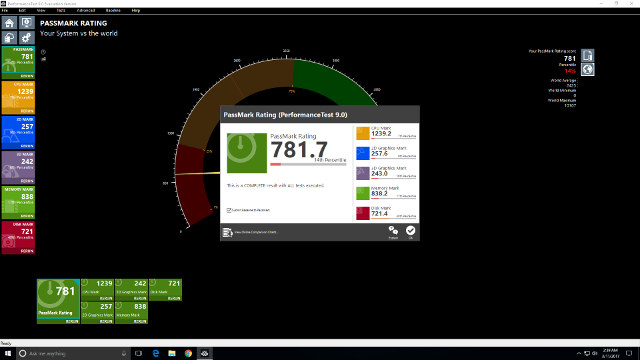
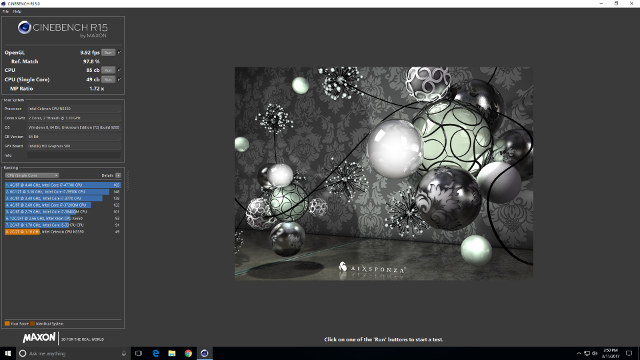
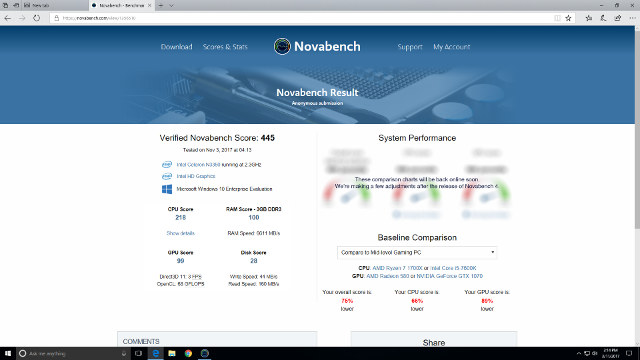
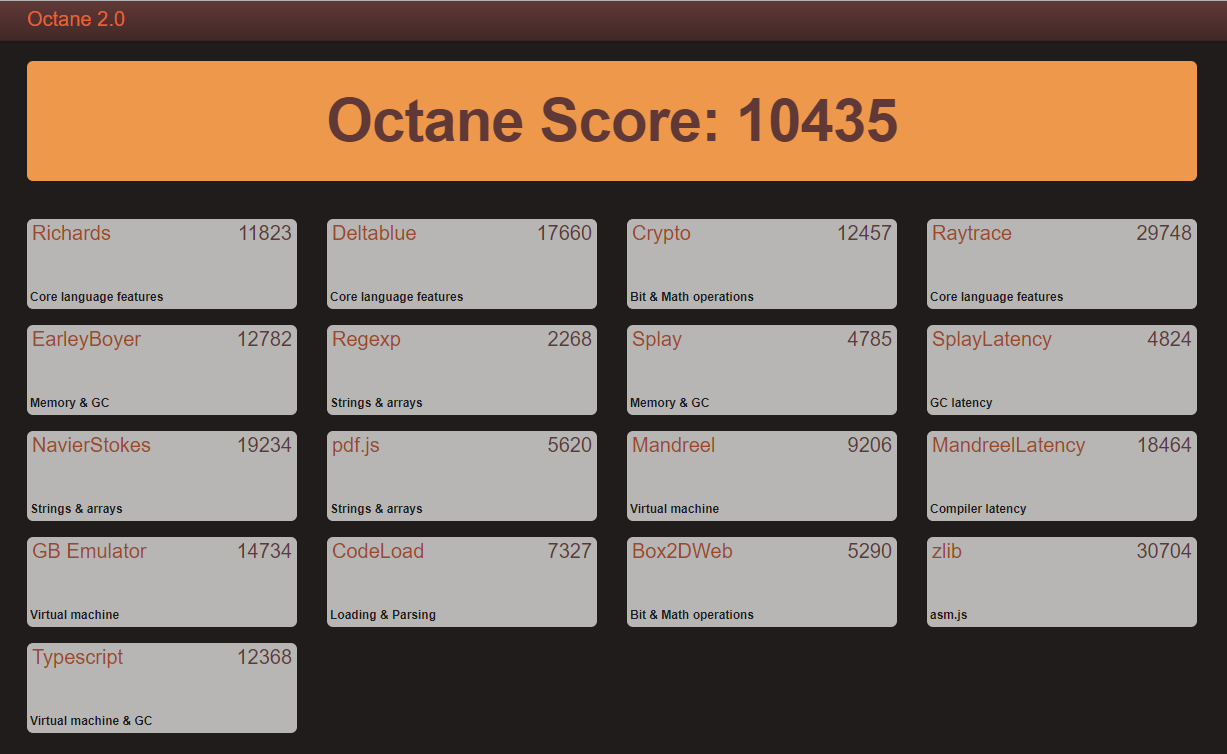
As can be seen the performance is as expected for the N3350 SoC and is comparable with other devices such as ECDREAM A9 or Beelink AP34 Ultimate:
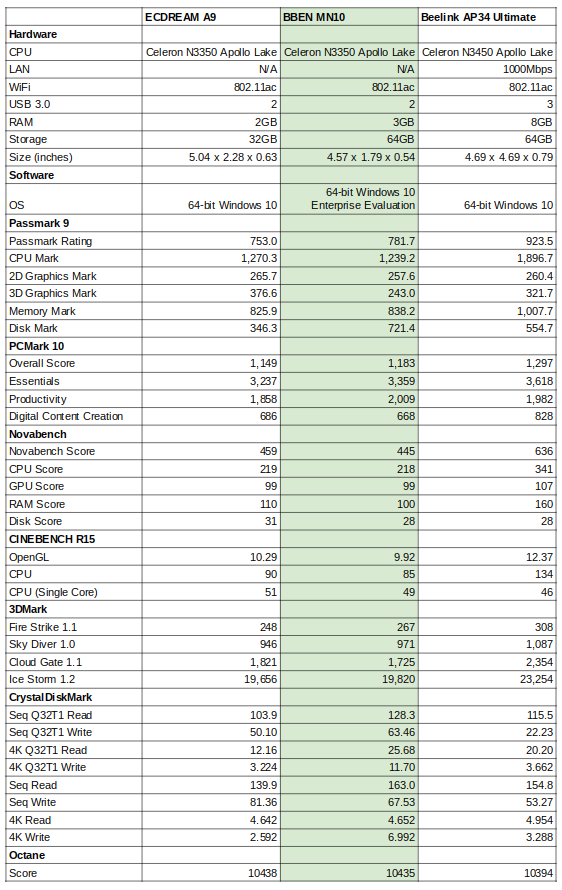
Next I installed Ubuntu as dual-boot using my ‘isorespin.sh’ script, which includes installing the rEFInd bootloader to enable booting on Apollo Lake devices when the BIOS doesn’t support Linux:
Performance is again as expected:
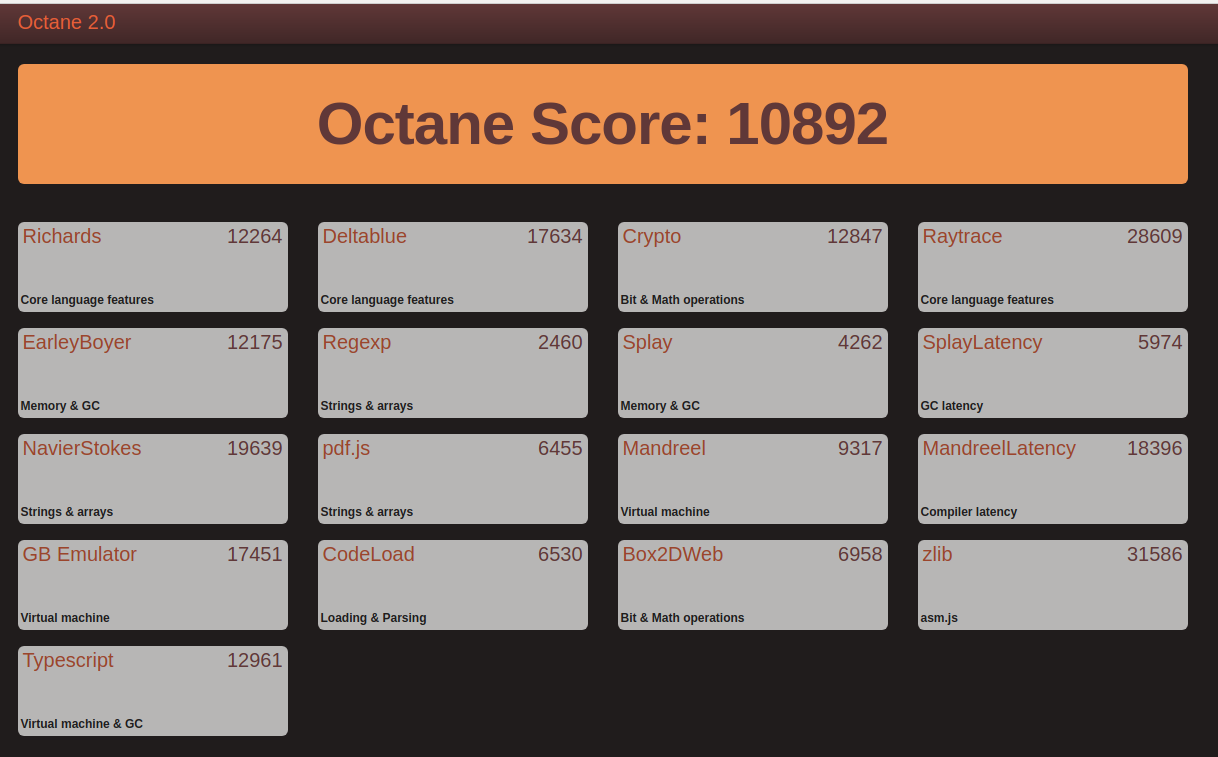
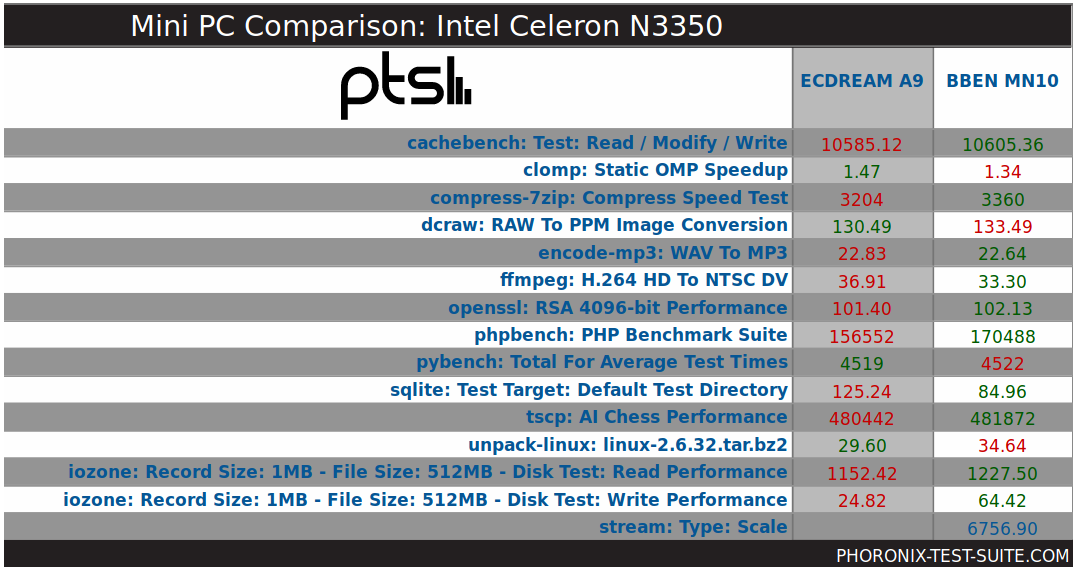
And can be compared with other Intel Apollo Lake and earlier Intel Atom devices:
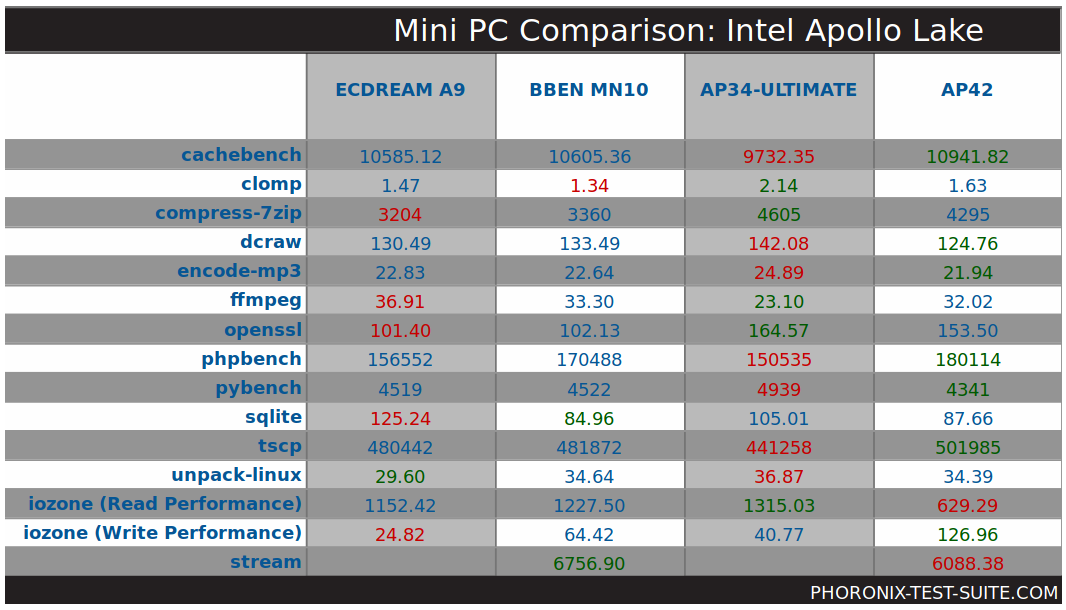
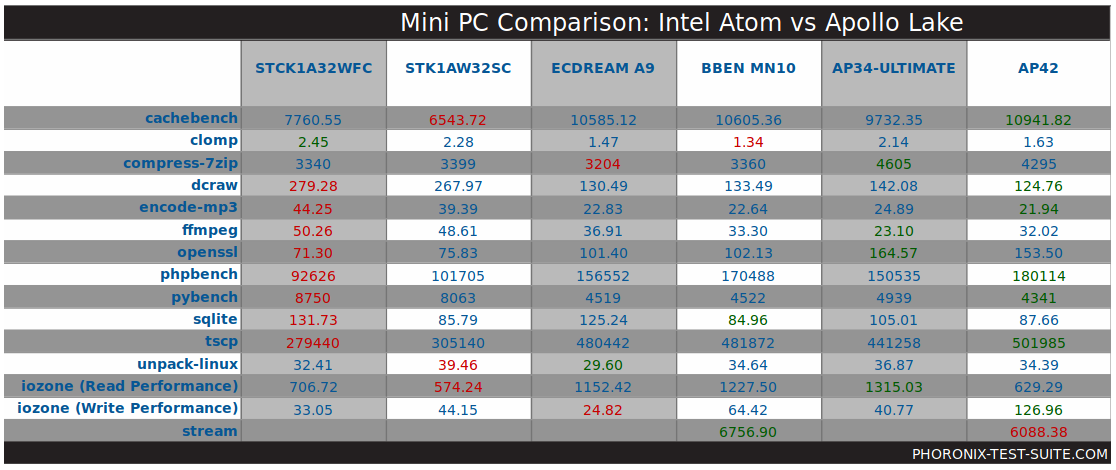
Revisiting the hardware using Linux commands additionally shows the micro SD card is running the slower HS200 interface:
|
1 2 3 4 5 6 7 8 9 10 11 12 13 14 15 16 17 18 19 20 21 22 23 24 25 26 27 28 29 30 31 32 33 34 35 36 37 38 39 40 41 42 43 44 45 46 47 48 49 50 51 52 53 54 55 56 57 58 59 60 61 62 63 64 65 66 67 68 69 70 71 72 73 74 75 76 77 78 79 80 81 82 83 84 85 86 87 88 89 90 91 92 93 94 95 96 97 98 99 100 101 102 103 104 105 106 107 108 109 110 111 112 113 114 115 116 117 118 119 120 121 122 123 124 125 126 127 128 129 130 131 132 133 134 135 136 137 138 139 140 141 142 143 144 145 146 147 148 149 150 151 152 153 154 155 156 157 158 159 160 161 162 163 164 165 166 167 168 |
linuxium@MN10:~$ lsb_release -a Distributor ID: Ubuntu Description: Ubuntu 17.04 Release: 17.04 Codename: zesty linuxium@MN10:~$ linuxium@MN10:~$ uname -a Linux MN10 4.10.0-19-generic #21-Ubuntu SMP Thu Apr 6 17:04:57 UTC 2017 x86_64 x86_64 x86_64 GNU/Linux linuxium@MN10:~$ linuxium@MN10:~$ inxi -Fc0 System: Host: MN10 Kernel: 4.10.0-19-generic x86_64 (64 bit) Desktop: Gnome Distro: Ubuntu 17.04 Machine: Device: desktop System: Default string product: Default string v: Default string Mobo: Default string model: Default string v: Default string UEFI: American Megatrends v: V1.1_3G date: 02/10/2017 CPU: Dual core Intel Celeron N3350 (-MCP-) cache: 1024 KB clock speeds: max: 2400 MHz 1: 1199 MHz 2: 1199 MHz 3: 2391 MHz Graphics: Card: Intel Device 5a85 Display Server: X.Org 1.19.3 drivers: modesetting (unloaded: fbdev,vesa) Resolution: 1920x1080@60.00hz GLX Renderer: Mesa DRI Intel HD Graphics 500 (Broxton 2x6) GLX Version: 3.0 Mesa 17.0.7 Audio: Card-1 Intel Celeron N3350/Pentium N4200/Atom E3900 Series Audio Cluster driver: snd_hda_intel Card-2 C-Media driver: USB Audio Sound: Advanced Linux Sound Architecture v: k4.10.0-19-generic Network: Card: Intel Wireless 3165 driver: iwlwifi IF: wlp1s0 state: up mac: 00:21:5c:af:a3:07 Drives: HDD Total Size: NA (-) ID-1: /dev/mmcblk1 model: N/A size: 62.5GB Partition: ID-1: / size: 9.8G used: 6.7G (73%) fs: ext4 dev: /dev/mmcblk1p5 RAID: No RAID devices: /proc/mdstat, md_mod kernel module present Sensors: System Temperatures: cpu: 39.0C mobo: N/A Fan Speeds (in rpm): cpu: N/A Info: Processes: 201 Uptime: 8 min Memory: 703.9/2774.8MB Client: Shell (review-tests.sh) inxi: 2.3.8 linuxium@MN10:~$ linuxium@MN10:~$ df -h Filesystem Size Used Avail Use% Mounted on udev 1.4G 0 1.4G 0% /dev tmpfs 278M 8.8M 269M 4% /run /dev/mmcblk1p5 9.8G 6.7G 2.6G 73% / tmpfs 1.4G 12K 1.4G 1% /dev/shm tmpfs 5.0M 4.0K 5.0M 1% /run/lock tmpfs 1.4G 0 1.4G 0% /sys/fs/cgroup /dev/mmcblk1p1 60M 47M 14M 78% /boot/efi tmpfs 278M 148K 278M 1% /run/user/1000 /dev/mmcblk1p3 48G 16G 33G 32% /media/linuxium/Windows linuxium@MN10:~$ linuxium@MN10:~$ lsblk -a NAME MAJ:MIN RM SIZE RO TYPE MOUNTPOINT loop0 7:0 0 0 loop loop1 7:1 0 0 loop loop2 7:2 0 0 loop loop3 7:3 0 0 loop loop4 7:4 0 0 loop loop5 7:5 0 0 loop loop6 7:6 0 0 loop loop7 7:7 0 0 loop mmcblk1 179:0 0 58.2G 0 disk ├─mmcblk1p1 179:1 0 64M 0 part /boot/efi ├─mmcblk1p2 179:2 0 16M 0 part ├─mmcblk1p3 179:3 0 47.6G 0 part /media/linuxium/Windows ├─mmcblk1p4 179:4 0 564M 0 part └─mmcblk1p5 179:5 0 10G 0 part / mmcblk1boot0 179:8 0 4M 1 disk mmcblk1boot1 179:16 0 4M 1 disk mmcblk1gp0 179:24 0 8M 0 disk mmcblk1rpmb 179:32 0 4M 0 disk linuxium@MN10:~$ linuxium@MN10:~$ sudo lshw -C cpu *-cpu description: CPU product: Intel(R) Celeron(R) CPU N3350 @ 1.10GHz vendor: Intel Corp. physical id: 38 bus info: cpu@0 version: Intel(R) Celeron(R) CPU N3350 @ 1.10GHz slot: SOCKET 0 size: 2299MHz capacity: 2400MHz width: 64 bits clock: 100MHz capabilities: x86-64 fpu fpu_exception wp vme de pse tsc msr pae mce cx8 apic sep mtrr pge mca cmov pat pse36 clflush dts acpi mmx fxsr sse sse2 ss ht tm pbe syscall nx pdpe1gb rdtscp constant_tsc art arch_perfmon pebs bts rep_good nopl xtopology tsc_reliable nonstop_tsc aperfmperf tsc_known_freq pni pclmulqdq dtes64 monitor ds_cpl vmx est tm2 ssse3 sdbg cx16 xtpr pdcm sse4_1 sse4_2 x2apic movbe popcnt tsc_deadline_timer aes xsave rdrand lahf_lm 3dnowprefetch cat_l2 intel_pt tpr_shadow vnmi flexpriority ept vpid fsgsbase tsc_adjust smep erms mpx rdt_a rdseed smap clflushopt sha_ni xsaveopt xsavec xgetbv1 xsaves dtherm ida arat pln pts cpufreq configuration: cores=2 enabledcores=2 threads=2 linuxium@MN10:~$ linuxium@MN10:~$ sudo lshw -C memory *-firmware description: BIOS vendor: American Megatrends Inc. physical id: 0 version: V1.1_3G date: 02/10/2017 size: 64KiB capacity: 5056KiB capabilities: pci upgrade shadowing cdboot bootselect socketedrom edd int13floppy1200 int13floppy720 int13floppy2880 int5printscreen int14serial int17printer acpi usb biosbootspecification uefi *-memory description: System Memory physical id: 30 slot: System board or motherboard size: 3GiB *-bank:0 description: DIMM DDR3 Synchronous 1600 MHz (0.6 ns) vendor: 0000 physical id: 0 serial: 00000000 slot: ChannelA-DIMM0 size: 1536MiB width: 16 bits clock: 1600MHz (0.6ns) *-bank:1 description: DIMM DDR3 Synchronous 1600 MHz (0.6 ns) vendor: 0000 physical id: 1 serial: 00000000 slot: ChannelA-DIMM1 size: 1536MiB width: 16 bits clock: 1600MHz (0.6ns) *-bank:2 description: DIMMProject-Id-Version: lshwReport-Msgid-Bugs-To: FULL NAME <EMAIL@ADDRESS>POT-Creation-Date: 2009-10-08 14:02+0200PO-Revision-Date: 2012-02-02 13:04+0000Last-Translator: Joel Addison <jaddi27@gmail.com>Language-Team: English (Australia) <en_AU@li.org>MIME-Version: 1.0Content-Type: text/plain; charset=UTF-8Content-Transfer-Encoding: 8bitX-Launchpad-Export-Date: 2017-04-04 11:54+0000X-Generator: Launchpad (build 18335) [empty] physical id: 2 slot: ChannelB-DIMM0 *-bank:3 description: DIMMProject-Id-Version: lshwReport-Msgid-Bugs-To: FULL NAME <EMAIL@ADDRESS>POT-Creation-Date: 2009-10-08 14:02+0200PO-Revision-Date: 2012-02-02 13:04+0000Last-Translator: Joel Addison <jaddi27@gmail.com>Language-Team: English (Australia) <en_AU@li.org>MIME-Version: 1.0Content-Type: text/plain; charset=UTF-8Content-Transfer-Encoding: 8bitX-Launchpad-Export-Date: 2017-04-04 11:54+0000X-Generator: Launchpad (build 18335) [empty] physical id: 3 slot: ChannelB-DIMM1 *-cache:0 description: L1 cache physical id: 36 slot: CPU Internal L1 size: 112KiB capacity: 112KiB capabilities: synchronous internal write-back configuration: level=1 *-cache:1 description: L2 cache physical id: 37 slot: CPU Internal L2 size: 1MiB capacity: 1MiB capabilities: synchronous internal write-back unified configuration: level=2 linuxium@MN10:~$ linuxium@MN10:~$ free -mh total used free shared buff/cache available Mem: 2.7G 648M 1.2G 183M 895M 1.7G Swap: 472M 0B 472M linuxium@MN10:~$ linuxium@MN10:~$ sudo lshw -C network *-network description: Wireless interface product: Wireless 3165 vendor: Intel Corporation physical id: 0 bus info: pci@0000:01:00.0 logical name: wlp1s0 version: 81 serial: 00:21:5c:af:a3:07 width: 64 bits clock: 33MHz capabilities: pm msi pciexpress bus_master cap_list ethernet physical wireless configuration: broadcast=yes driver=iwlwifi driverversion=4.10.0-19-generic firmware=22.391740.0 ip=XXX.XXX.XXX.XXX latency=0 link=yes multicast=yes wireless=IEEE 802.11 resources: irq:370 memory:92100000-92101fff linuxium@MN10:~$ linuxium@MN10:~$ dmesg | grep "MMC card" [ 3.045916] mmc1: new HS200 MMC card at address 0001 linuxium@MN10:~$ |
and rather interestingly a S/PDIF audio interface shows up in the sound settings. However given there is only a 3.5mm audio jack and when an external speaker is connected through it, sound works when selecting the S/PDIF interface. This again is somewhat misleading.
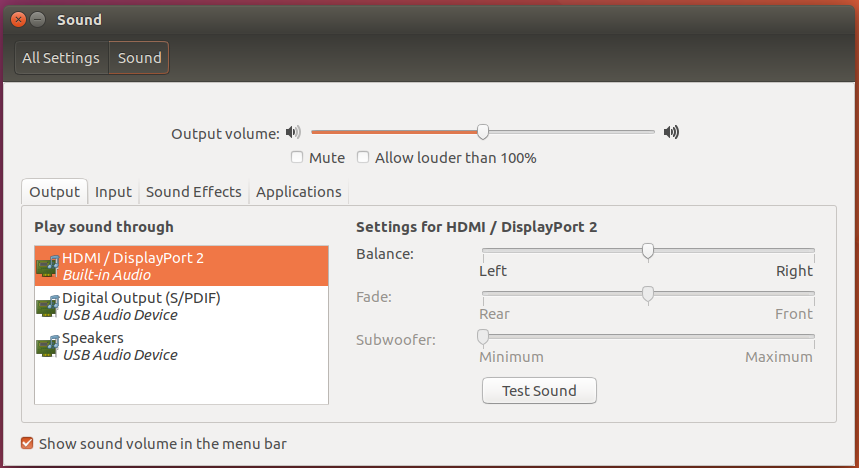
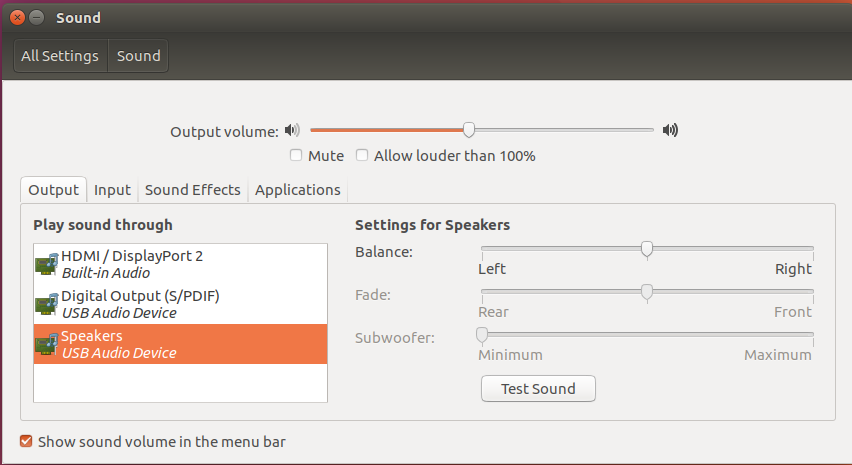
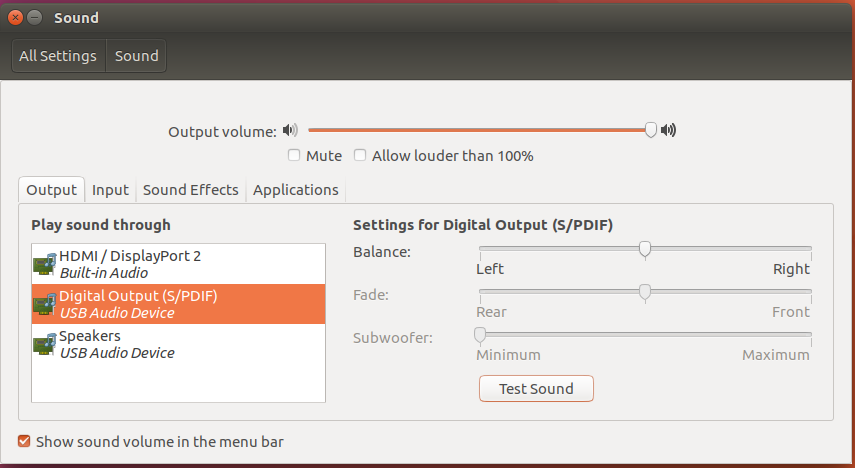
Looking at real-work Windows usage cases the first being watching a 4K video using Microsoft Edge which works flawlessly:
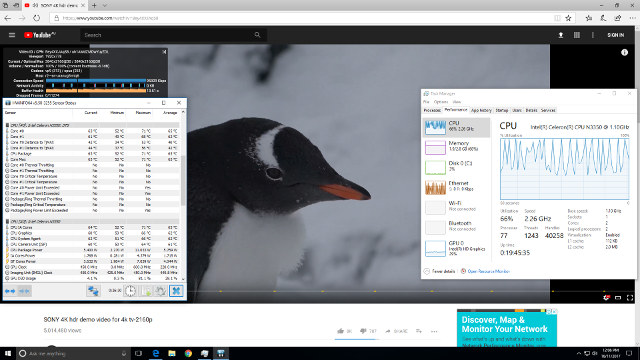
The same video when watched using Google Chrome results in occasional dropped frames:
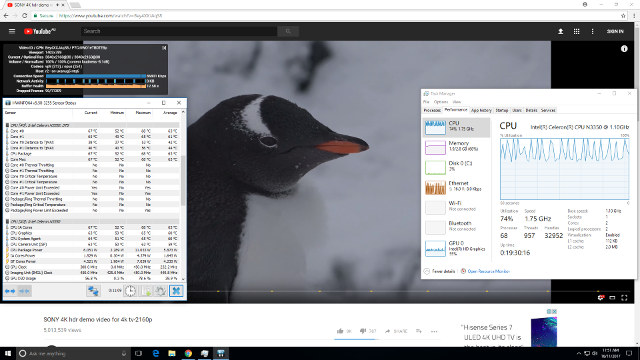
but notice how much harder the CPU and GPU are working.
Watching the same video and changing the video quality to high definition (1080p resolution) results in a better experience.
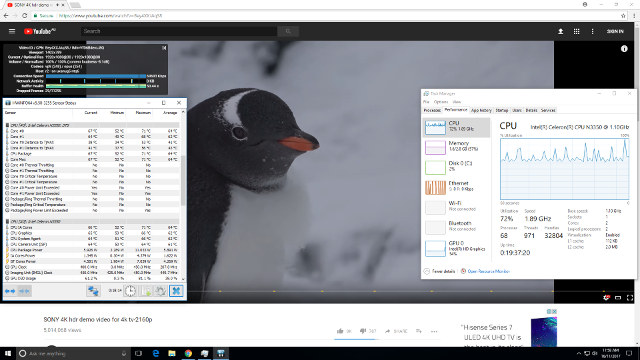
Unfortunately this can’t be said for watching the same video in Google Chrome on Ubuntu. At 4K the video is unwatchable with excessive dropped frames and a stalled network connection after a short while:
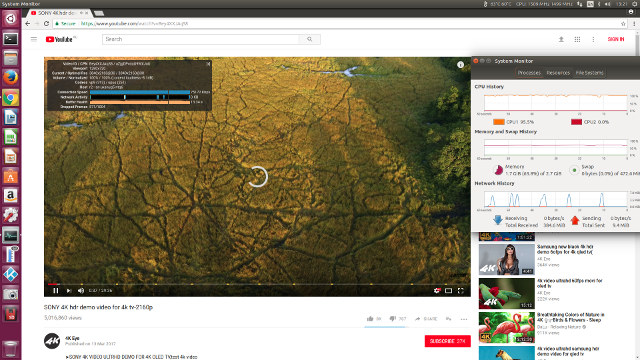
Even at 1080p the video still stutters:
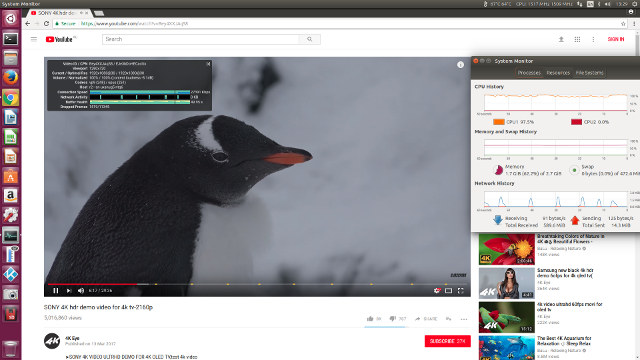
Running Kodi on both Windows and Ubuntu show similar ‘differences’ in the results.
On Windows if the video is encoded using the VP9 codec then decoding is using software resulting in high CPU usage and high internal temperatures:
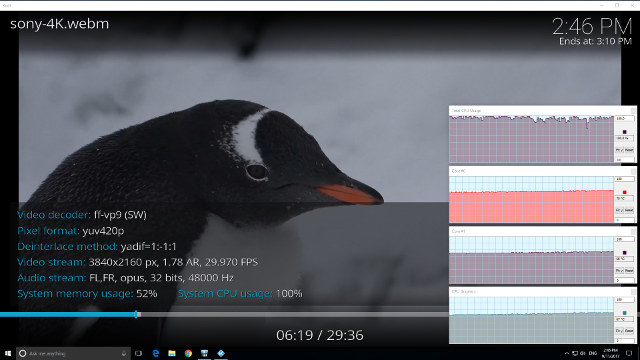
However when the video is encoded with the H.264 codec then Windows uses hardware to decode:
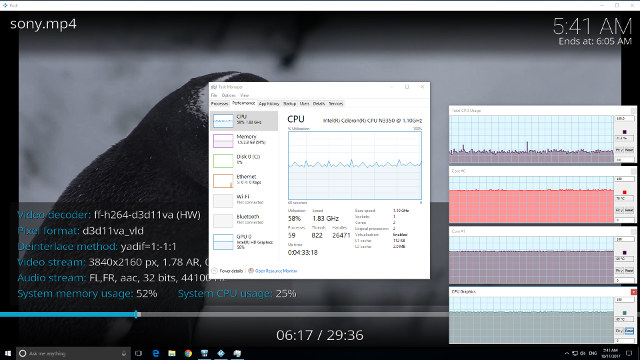
and similar for videos encoded with H.265 or HEVC:
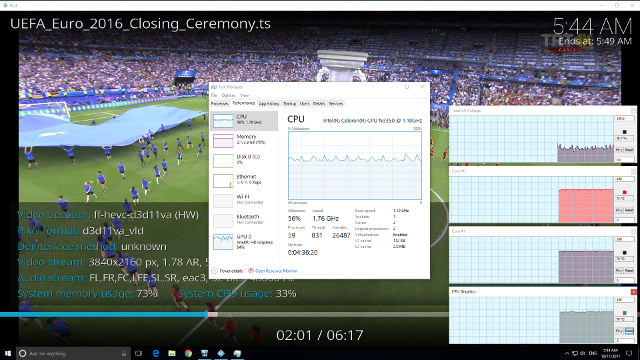
with no issues playing the videos.
On Ubuntu hardware is used to decode all three codecs:
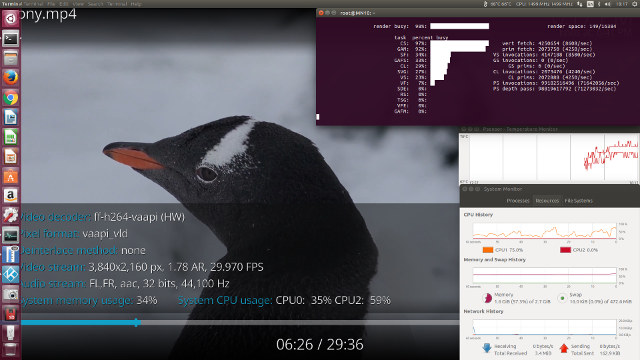
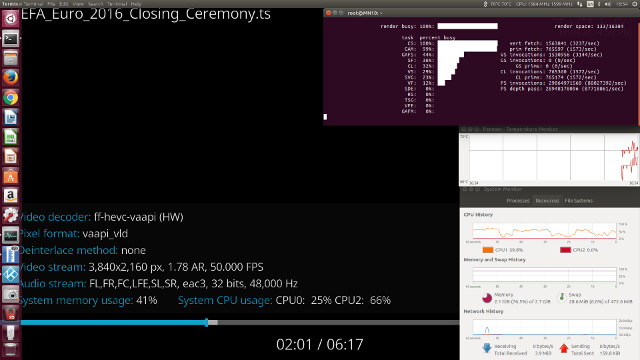
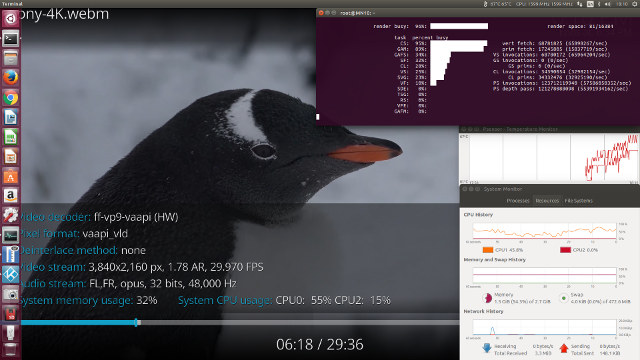
however some H.265 videos resulted in a blank (black) screen just with audio whereas others played without issue:
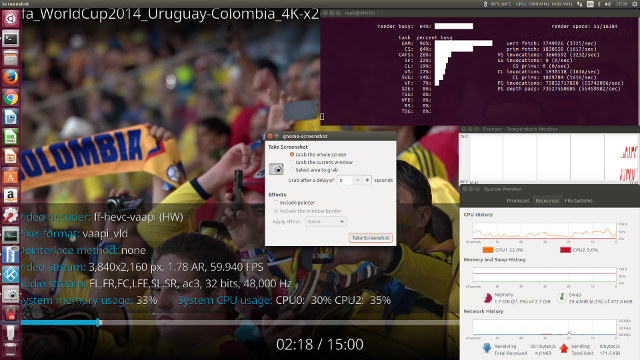
As previously mentioned the internal fan is screaming away merrily although it’s effectiveness with internal cooling is somewhat questionable:
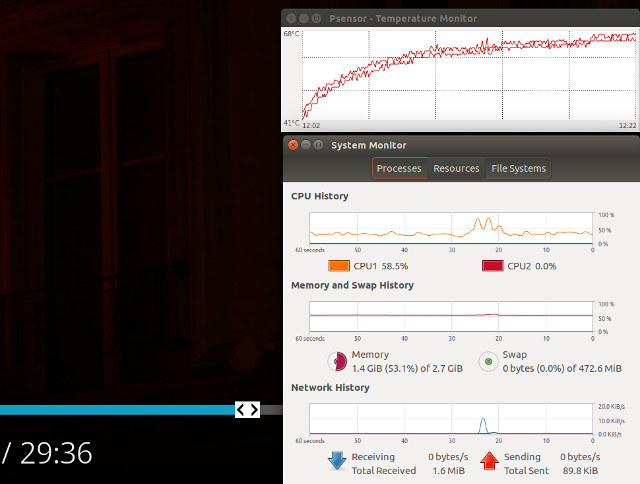
It does assist in keeping the device at a safe external temperature:
with the highest observed reading being 41°C.
So looking at the physical characteristics of the device its size is only slightly larger than the second generation Intel Compute Stick:
Initially I used the device upside down as it seemed sensible to have the case vents exposed:
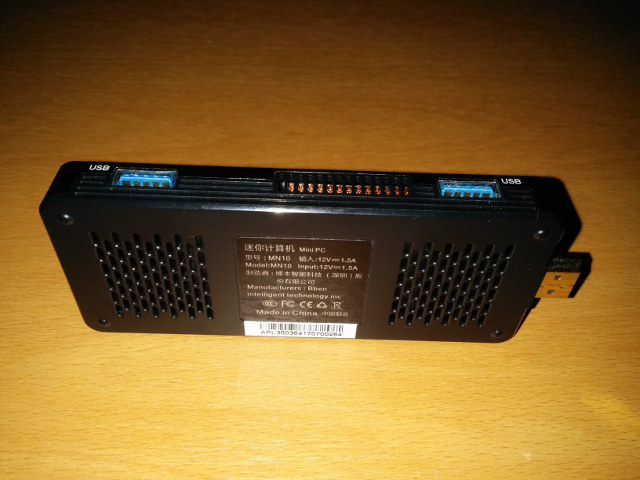
However cracking open the case reveals the fan actually uses the side vent between the two USB ports:
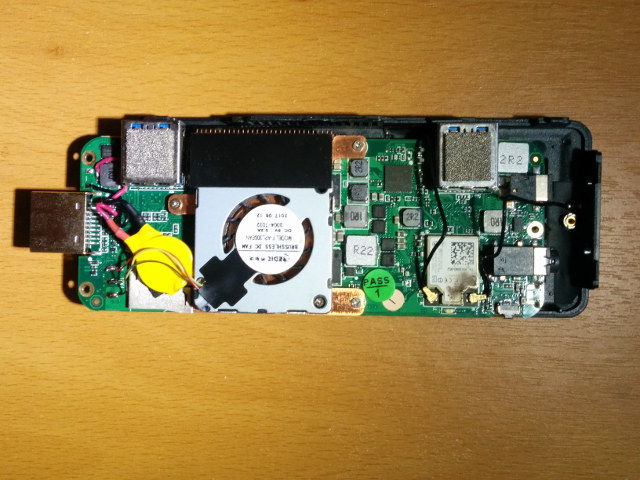
with the bottom vents for cooling the memory and storage chips:
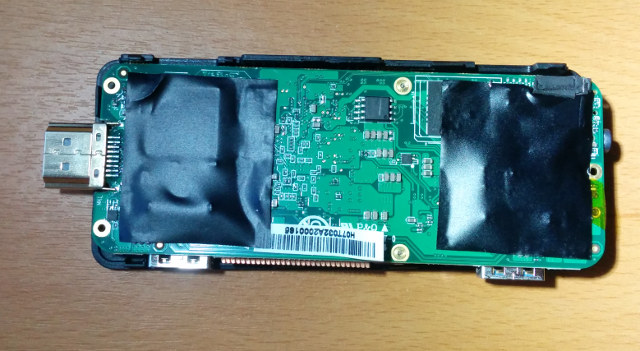
Remarkably the WiFi chip appeared to have been exposed to excessive heat at some stage:
yet had still passed inspection as evidenced by the green ‘Pass’ sticker.
The only identifiable marking on the board were on the bottom under the sticky black coverings:
The BIOS is minimalistic:
which is an issue when booting with a connected USB to Ethernet adapter, as it defaults to PXE booting which needs to timeout before booting occurs from internal storage. A workaround is to boot Windows from the boot menu after pressing F7:
Notice also that the BIOS is unbranded and simply displays the Intel logo.
Finally after using Windows then Ubuntu and returning to Windows I encountered that audio over HDMI had disappeared:
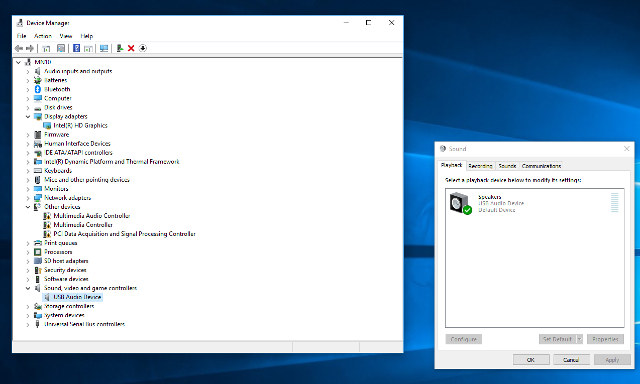
and reinstalling the Intel HD Graphics driver didn’t fix it.
So to sum up this is a device with specific limitations which the buyer should be aware of prior to purchase. I’d like to thank Gearbest for providing the BBEN MN10 for review. They sell it for $197.42 shipped. You’ll also find it on Aliexpress from various sellers with not-activated or activated Windows 10 Home / Pro.

Ian is interested in mini PCs and helps with reviews of mini PCs running Windows, Ubuntu and other Linux operating systems. You can follow him on Facebook or Twitter.
Support CNX Software! Donate via cryptocurrencies, become a Patron on Patreon, or purchase goods on Amazon or Aliexpress


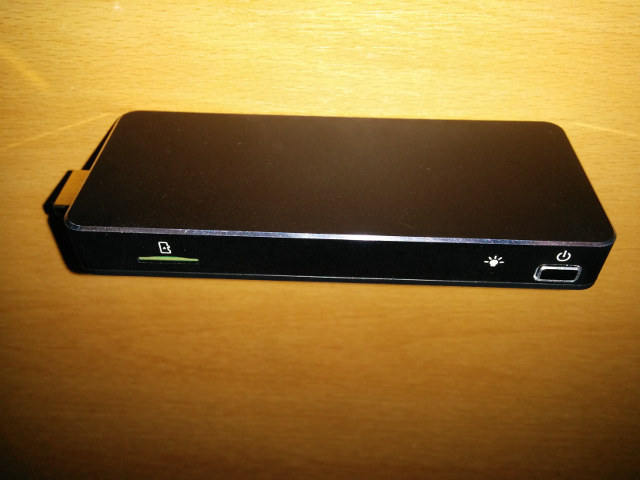

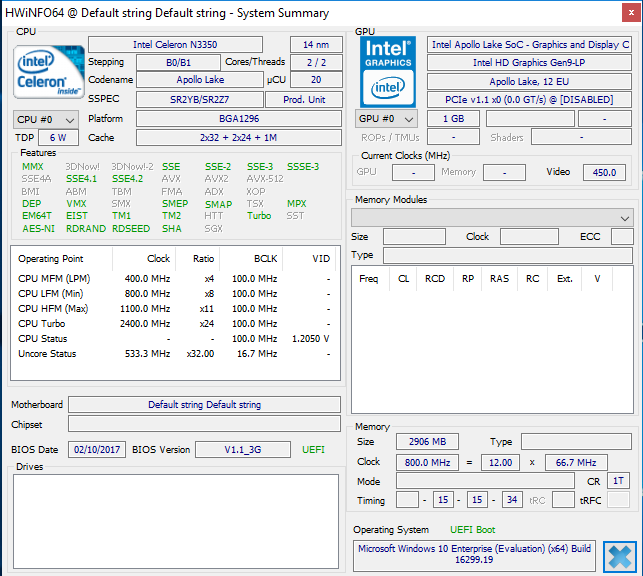
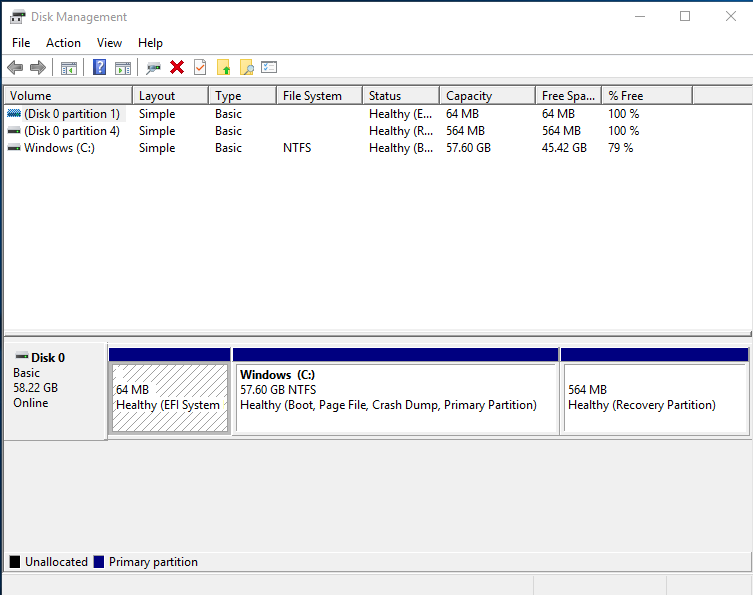
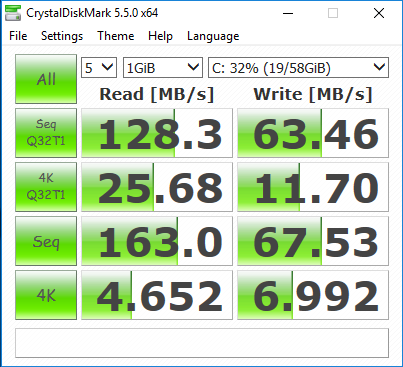
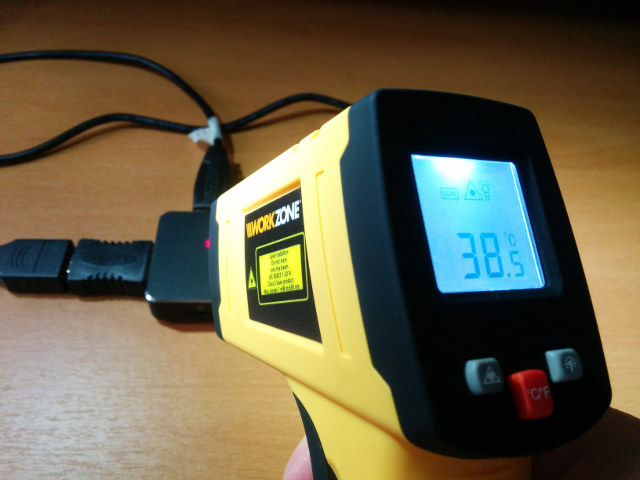
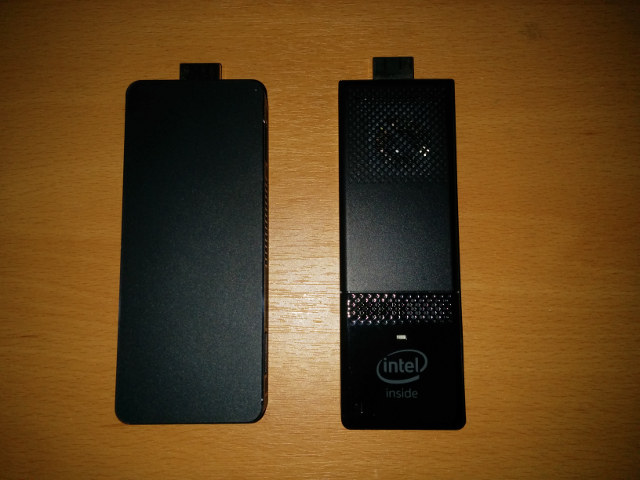
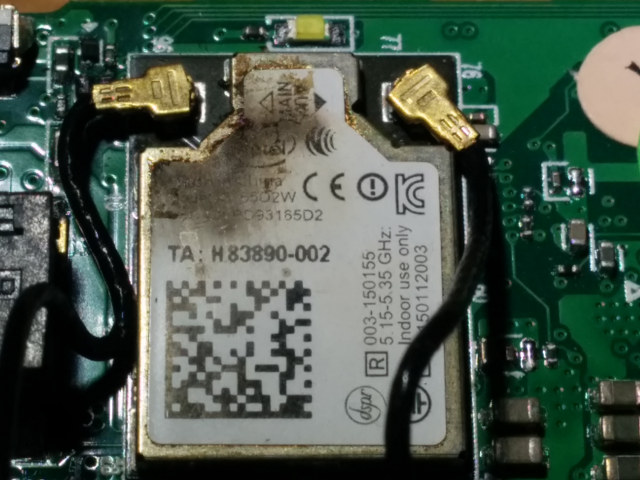
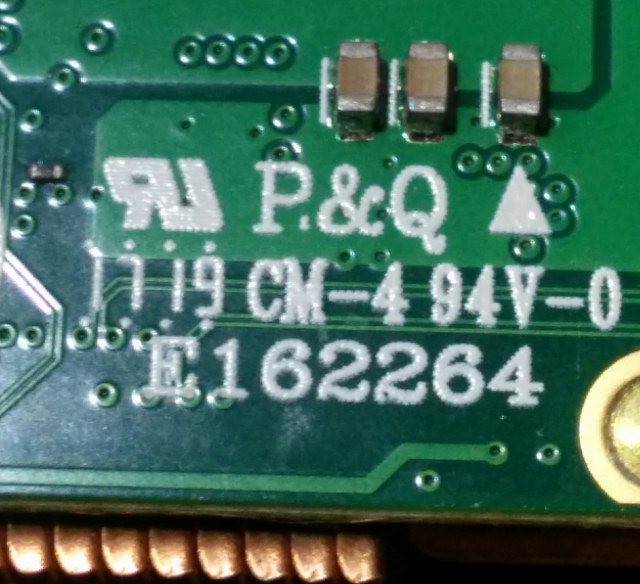



Ok. This is garbage.
Better wait for chinese cheap laptops with Gemini Lake in 2018.
Lol even wifi chips are salvaged (possibly from a domestic fire) and reused these days?
Did you solve the problem with the drivers of these three devices? I have the same problem
I contacted the manufacturer and received a full set of drivers. the problem is fixed. if you need a link to the driver, then write
Hi. It would be great.
Hi! I need link to the driver. Please
I want to buy this stick from aliexpress, but i have some questions:
First Question is: I understand that this stick is noisy, but Can i controll the fan with programs? or in bios has this option
Second Question is: How is scalling in this stick in light games? and Did they (Intel) fixed the problems with sound in the drivers?